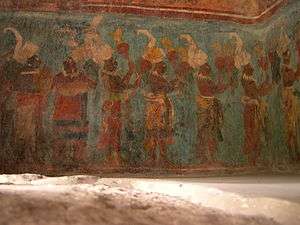Visual arts of Mexico

Visual arts of Mexico are any visual art made in Mexico, from prehistoric times to the present. These include indigenous, Spanish colonial, post-independence nineteenth century painters, twentieth century and post-revolutionary art; print makers, photographers and sculptors influenced by European modernism; Contemporary art. Painting is one of the oldest arts of Mexico. In pre-Hispanic central and southern Mexico it is present in Aztec codices, ceramics, clothes, etc.; examples are the Mayan murals of Bonampak in the southeast, the Teotihuacan in central Mexico, Cholula and Monte Alban in southern Mexico. It is believed that the American continent's oldest rock art, 7500 years old, is found in a cave on the peninsula of Baja California.[1]
New Spain painting from the 16th and 17th
The mural blossomed during the sixteenth century in religious building (for example, the convents of Acolman, Huejotzingo, Tecamachalco, and Zinacantepec) and houses of the nobility.
For a time it was believed that the first European painter living in New Spain was Rodrigo de Cifuentes (apocryphal artist), to whom were attributed works such as "Baptism of the chiefs of Tlaxcala" and an altarpiece painting in the Convent of San Francisco in Tlaxcala. Among native painters was Marcos Aquino. A Flemish painter Simon Pereyns came to New Spain in 1566 and is considered the most important painter of this era. Pereyns along with Francisco de Morales, Francisco de Zumaya and Andrés de la Concha Juan de Arrúe formed a group of educated painters. The works preserved by this Flemish artist are, among others, his altarpiece paintings of Huejotzingo and San Cristóbal at the Metropolitan Cathedral.
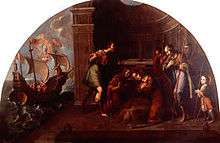

The church produced the most important works of the seventeenth century. Among the important painters were Baltasar de Echave Ibia and his son Baltasar Echave Rioja, also Luis Juárez and his son José Juárez, Juan Correa, Cristóbal de Villalpando, Rodrigo de la Piedra, Antonio de Santander, Polo Bernardino, Juan de Villalobos, Juan Salguero and Juan de Herrera. Juan Correa, worked from 1671 to 1716 and reached great prestige and reputation for the quality of its design and scale of some of his works. Among the best known: 'Apocalypse in the Cathedral of Mexico', 'Conversion of St. Mary Magdalene', now in the 'Pinacoteca Virreinal' and 'Santa Catarina and Adam and Eve casting out of paradise', the latter located in the National Museum of Viceroyalty of Tepotzotlán.[2]
Caravaggio and Francisco de Zurbarán as Painter of the King greatly influenced the artistic creation of this period. From latter many works for the churches of New Spain were brought. At the end of the Baroque period, Bartolome Esteban Murillo works were present in New Spanish workshops.
 Cristóbal de Villalpando, Woman of the Apocalypse (Mujer del Apocalipsis), 1686
Cristóbal de Villalpando, Woman of the Apocalypse (Mujer del Apocalipsis), 1686.png) Cristóbal de Villpando, The Virgin of the Apocalypse (La Virgen de la Apocalipsis). Late 17th century
Cristóbal de Villpando, The Virgin of the Apocalypse (La Virgen de la Apocalipsis). Late 17th century Cristóbal de Villalpando, Saint Rose tempted by the devil (Santa rosa tentada por el demonio), ca. 1695/1697
Cristóbal de Villalpando, Saint Rose tempted by the devil (Santa rosa tentada por el demonio), ca. 1695/1697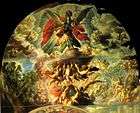 Cristóbal de Villalpando, Apparition of Saint Michael (Aparición de San Miguel), ca. 1686-1688
Cristóbal de Villalpando, Apparition of Saint Michael (Aparición de San Miguel), ca. 1686-1688 Cristóbal de Villalpando, View of the Plaza Mayor of Mexico city (Vista de la Plaza Mayor de la Ciudad de México), 1695
Cristóbal de Villalpando, View of the Plaza Mayor of Mexico city (Vista de la Plaza Mayor de la Ciudad de México), 1695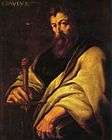 Cristóbal de Villalpando, Saint Paul (San Pablo), 1670-1680
Cristóbal de Villalpando, Saint Paul (San Pablo), 1670-1680.jpg) Cristóbal de Villalpando, Madonna of the Stairs (La Virgen de la Escalera), 1680-1690
Cristóbal de Villalpando, Madonna of the Stairs (La Virgen de la Escalera), 1680-1690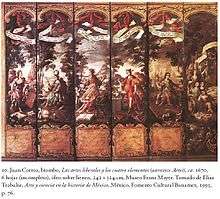 Juan Correa, The liberal arts and the four elements (Las artes liberales y los cuatro elementos). 1670
Juan Correa, The liberal arts and the four elements (Las artes liberales y los cuatro elementos). 1670
New Spain 18th century painting


Along with the construction of temples and houses artistic religious themes proliferated. In New Spain, as in the rest of the New World, since the seventeenth century, particularly during the eighteenth century, the portrait became an important part of the artistic repertoire. In a society characterized by a deep religious feeling which was imbued, it was expected that many portraits reflected the moral virtues and piety of the model.[3]

Some prominent painters of this period are: Cristóbal de Villalpando, Juan Correa, José de Ibarra, Joseph Mora, Nicolas Rodriguez Juarez, Francisco Martinez, Miguel Cabrera, Andrés López and Nicolás Enríquez. Sebastian Zalcedo painted ca. 1780 a beautiful allegory of the Virgin of Guadalupe in oil on copper foil. In this century Josep Antonio de Ayala was a prominent artist, who is known for painting The family of the Valley at the foot of Our Lady of Loreto c. 1769. This devotional painting was commissioned to be done for the children of the del Valle family in memory of his parents and is characteristic of the painting of this century.[4]
A description of colonial art says: "In the "Sponsorship of Saint Joseph on the Caroline College", Saint Joseph is seen as a major figure of the work, who carries on his left side the child Jesus. Two archangels flank him and maintain its long purple robe. At the top two little angels are observed with intent to crown the holy". "For centuries, the work was attributed to Manuel Caro, but the meticulous restoration work allowed to find the signature of the original author. Miguel Cabrera"[5]
Secular art emerged as an important development in the eighteenth century, partiucarly casta paintings, depictions of the system of racial hierarchy. Accomplished religious artists, such as Miguel Cabrera, painted a set of casta paintings; Cabrera also painted elites in New Spain as well as cultural icons, such as Sor Juana Inés de la Cruz. Some painters like Nicolas Rodriguez Juarez, were involved in the implementation of triumphal entry to the viceroys and archbishops magistrates arches. The poblano José Luis Rodríguez Alconedo was the last novohispano (Mexican) painter.
 The Parian (El Parián), ca. 1770
The Parian (El Parián), ca. 1770 Manuel Arellano, Inauguration of the Sanctuary of the Virgin of Guadalupe in Mexico city (Traslado de la imagen y dedicación del santuario de Guadalupe en la Ciudad de México), 1709
Manuel Arellano, Inauguration of the Sanctuary of the Virgin of Guadalupe in Mexico city (Traslado de la imagen y dedicación del santuario de Guadalupe en la Ciudad de México), 1709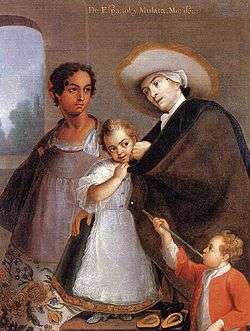 Miguel Cabrera, Painting of Castes (Pintura de las Castas), 1763
Miguel Cabrera, Painting of Castes (Pintura de las Castas), 1763 Portrait of family Fagoga Arozqueta (Retrato de la Familia Fagoga Arozqueta), 1730
Portrait of family Fagoga Arozqueta (Retrato de la Familia Fagoga Arozqueta), 1730
19th century Mexican painting
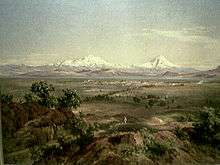
In this century there are examples of murals such as folkloric style created between 1855 and 1867 in La Barca, Jalisco.[6]
Highlights at this time: Pelegrín Clavé, Juan Cordero, Felipe Santiago Gutiérrez and José Agustín Arrieta. In Mexico, in 1846 he was hired to direct Pelegrín Clavé's reopening of the Academy of San Carlos, a body from which he promoted the historical and landscaping themes with a pro-European vision.[7]
Edouard Pingret painting reproduced customs and Mexican landscapes and encouraged his contemporaries to recreate the local customs and rural setting.
Hermenegildo Bustos is one of the most popular painters of the historiography of Mexican art. Also important in these years were Santiago Rebull, José Salomé Pina, Félix Parra, José Obregón, Rodrigo Gutiérrez, Leandro Izaguirre, Eugenio Landesio and his famous disciple, the landscapist José María Velasco and Julio Ruelas.
20th century Mexican painting
Some of the most prominent painters in this century are:


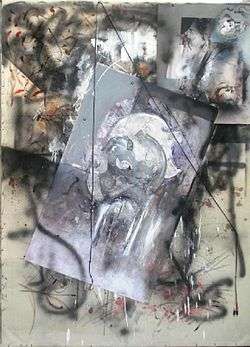
- David Alfaro Siqueiros, painter and muralist (Mural in Tecpan (Tlatelolco), Polyforum Cultural Siqueiros)
- Raul Anguiano, harmonic geometry, muralist and printmaker.
- Ignacio Barrios, watercolorist.
- Marta Chapa, oil.
- Mario Orozco Rivera, muralist and easel.
- Joaquín Clausell, oil, Impressionist.
- Miguel Condé, painter, draftsman and figurative recorder.
- Vladimir Cora, painter and sculptor, oil, acrylic and enamel.
- Pedro Coronel, painter, sculptor, draftsman and engraver abstract.
- Rafael Coronel oil, melancholy painting.
- Miguel Covarrubias, Art Deco cartoon.
- José Luis Cuevas, painter, sculptor.
- Claudio Ruanova Self-taught painter.
- Gunther Gerzso, oil, pioneer of Mexican (Abstract Surrealism Expressionism[8]).
- Francisco Goitia, oil
- Jorge González Camarena, painter, sculptor and muralist.
- Saturnino drawing, oil painting, frieze at the Palace of Fine Arts in Mexico city.
- María Izquierdo, oil painting, surreal, muralist, first Mexican painter to exhibit in the US.
- Frida Kahlo, oil, surreal.
- Gerardo Murillo Dr. Atl, Oil, (pioneer of "mural" in Mexico). Casino de la Selva
- Leonardo Nierman, painter and sculptor.
- Luis Nishizawa, artist (various techniques).
- Juan O'Gorman, mural (murals at UNAM, Mexico).
- Pablo O'Higgins, American-Mexican (SEP murals and the National School of Agriculture at Chapingo) muralist.
- José Clemente Orozco, mural (murals in the Palacio de Bellas Artes, Hospicio Cabañas).
- José Guadalupe Posada, engraving.
- Rivera, painter and muralist (National Preparatory School, Palace of Fine Arts, School of Agriculture at Chapingo).
- Federico Cantú,[9] muralist, printmaker and sculptor.
- Leonora Carrington, painter and novelist of English origin.
- Juan Soriano "The Mozart of Mexican painting."
- Tamayo, oil, mixography, muralist.
- Francisco Toledo, painter, sculptor and ceramist.
- Rodrigo R. Pimentel painter.
- Remedios Varo, surrealist painter.
- Alfredo Zalce, muralist, printmaker and sculptor.
- Roberto Montenegro.
- Gustavo Murueta painter, sculptor, draftsman and printmaker.
- Desiderio Hernández Xochitiotzin Tlaxcala muralist painter.
- July Ferrá, muralist painter.
The great Mexican muralists of the post-revolution developed, with the paint mural, the concept of "public art", an art to be seen by Ias masses in major public buildings of the time, and could not be bought and transported easily elsewhere, as with easel painting.[10]
Muralism

The boom in Mexican mural began in 1922 under the protection of José Vasconcelos, Secretary of Public Education. From this year to 1924 such important works as the frescoes of the temple of Saint Peter and Saint Paul (Dr. Atl, Roberto Montenegro and Xavier Guerrero); the Mural of the 'Amphitheater Bolívar' (by Diego Rivera, with the help of Carlos Mérida, Guerrero and Jean Charlot); And 'los frescos de la preparatoria' (José Clemente Orozco Garcia Cahelo, Alva De La Canal, Fernando Leal, Siqueiros and Fermín Revueltas).
In all these works, yet devoid of ideological content which would later dominated this post revolutionary Mexican theme, the characterization of popular themes and daring in the use of new materials and ranges; as well as influences of Italian Renaissance influences and religious spirit of old Mexico.
But soon, under the influence of Rivera and Siqueiros, the mural art was enriched by the momentum of the revolutionary movement which was characterized in the advanced socialist ideas and themes, Rivera's works were also charactirezed with some anti-religious and anti-Spanish and pro-indigenist themes. This process is illustrated on the walls of the Ministry of Education, where the work of Diego Rivera ranges from the folklore and popular decoration on the first floor, to the interpretations of proletarian aspirations to the last. With the departure of Vasconcelos Secretary of Education the facilities they had enjoyed ostentatiously declined for the muralists and that provoked a crisis of internal problems of the guild, which was disintegrated because of deep ideological differences among its arttists. Diego Rivera breaks his masterpiece in the School of Chapingo that was able to finish until 1929.
Modern Mexican painting
Some of the most prominent painters in this century are:
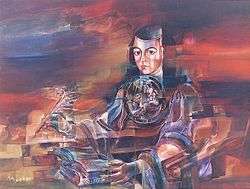

- Eliseo Garza Aguilar, painter and performance artist. Considered among the leading exponents of provocative and thoughtful art of the Third Millennium. In search of a critical response from viewers, combines his paintings in the performances with the theatrical histrionics.
- Emanuel Espintla, painter and performer. Considered among the leading exponents of Mexican naive art and Fridamania.
- Pilar Goutas, a painter who uses oil on amate support, strongly influenced by Pollock and Chinese calligraphy.
- Torres Rafael Correa he settled in Mexico in 2001 and joined the workshop of contemporary art, "The Moth" in Guadalajara, doing various art projects and scenographic . In Mexico works with painters, José Luis Malo, Rafael Sáenz, Edward Enhanced and sculptor Javier Malo. He participated in workshops recorded by the painter Margarita Pointelin. In 2003 he made a formation of Washi Zoo Kei with the Salvadoran master Addis Soriano.
- Enrique Pacheco, sculptor, painter, characterized by merge painting and sculpture with worldwide recognition.
- Pilar Pacheco Méndez, visual artist and sound.[11]
- Daniel Lezama, visual artist. Works on all major formats oil. Born in 1968 to Mexican American parents.
- Roberto Cortazar, visual artist, painter.
- Margarita Orozco Pointelin
- Jazzamoart, visual artist, Guanajuato.
- Rafael Cauduro, painter, sculptor, muralist.
- Arturo Rivera, Painter.
- Germán Montalvo, Painter.
- Vicente Rojo, Painter.
- Sebastian, painter, sculptor.
- Miguel Sanchez Lagrieta, Painter, visual artist.
- Gabriel Orozco, Painter, Sculptor Veracruz.
References
- ↑ Descubierta en una cueva de México la pintura rupestre más antigua de América / EL MUNDO Archived February 13, 2009, at the Wayback Machine.
- ↑ Arte y cultura en la colonia Archived October 13, 2008, at the Wayback Machine.
- ↑
- ↑ de Romero, Soumaya Slim; Garcia, Minerva Mogollan; Ayala Canseco, Eva Maria, eds. (2006). Seis Siglos de Arte, Cien Grandes Maestros de Romero. Fundacion Carso / Museo Soumaya. ISBN 9789687794303.
- ↑ "Puebla, Pue. México, Jueves 13 de Marzo de 2008". Comunicacion.buap.mx. Retrieved 2016-11-30.
- ↑
- ↑ "Pintura". Web.archive.org. 2007-10-15. Retrieved 2016-11-30.
- ↑ "La Jornada". Jornada.unam.mx. Retrieved 2016-11-30.
- ↑ boart (2014-12-23). "CANTU ART - FEDERICO CANTÚ 1907-1989". Web.archive.org. Retrieved 2016-11-30.
- ↑ "Archived copy". Archived from the original on May 24, 2010. Retrieved October 29, 2014.
- ↑ "Archived copy". Archived from the original on October 30, 2014. Retrieved October 29, 2014.
External links
- Prehispanic painting in Mexico
- Viceroyal art of the New Spain period
- National Museum of Viceroyalty
- The Pinacoteca Profesa
- Manuel G. Revilla and history of Mexican art in the nineteenth century
- Una Ciudad Invisible II. La Casa de las Mil Ventanas a study of Joaquín Clausell (Spanish)
- The Mexican Muralist Movement
- Polyforum Siqueiros
- Trouble Surrealism in contemporary Mexican painting Viviane Bigot. (Spanish)
- Gunther Gerzso: Defining Mexican Abstraccionism
- Academy of San Carlos
- New Spanish art in Soumaya museum
